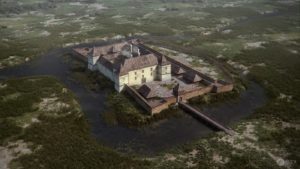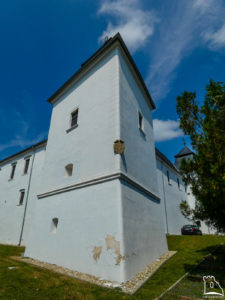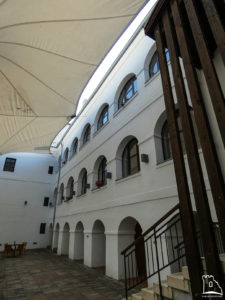Egervár

Egervár lies on the Western verge of the earlier marshy valley of the Sárvíz stream, on the border of Zala and Vas counties, along main road 74, north of Zalaegerszeg. The village today consists of Egervár and Dénesfa, two settlements that used to be separate. Enjoy the video: https://www.youtube.com/watch?v=qdNGMUGdeEs

The name Egervár is derived from the alder tree, which is abundant in its marshy environment, and its castle which existed already in the XIII century. It was first mentioned in writing in 1281. We have some sources mentioning its fortress first in 1288. According to a charter, there was a change in the ownership of the castle: Palatine János exchanged his castle and estates in Polosnicza with Bán Miklós for the caste of Egervár and its accessories.

This building, which on the basis of the customary architecture of the age, was probably made of wood, strengthened with wicker-work and stake lines, and stood in the middle of a marshy field, was destroyed between 1313 and 1325 during local wars. Later, when János and Mihály called themselves Egervári, sons of Kalmer from the Geregye dynasty, divided the estate between themselves, it was not mentioned anymore.

There were several famous families living or having the centers of their estates in the settlement. It belonged to the Egervári family in the XIV-XV centuries. Egervári László was the most prominent member of the family, who became one of the nobility during the reign of King Matthias Corvinus – as one of his confidential people –, and who was nominated by King Wladislas as Lord Chief Treasurer. He had the ancestor of today’s castle, and church, which is still standing in the settlement that was built in 1495.

It was dedicated to Saint Catherine. Next to the church, a Franciscan monastery was also built by 1510, the completion of which is linked to the name of bishop Egervári Bereck, another member of the family, which monastery, however, – was ruined with time. The settlement received the right of a borough from King Wladislas in 1497, and it remained so until the end of the XIX century, although with varying economic significance. We can evaluate the XV century as the golden age of Egervár.

The unique architectural style of the mature, already gothic-type Renaissance appeared here, thanks to Egervári László. The building workshop and the building units working here used not stone but terracotta as the material of ornamental elements. That is how the castle was built between 1477 and 1489, and the church between 1489 and 1495.

After the Egerváries, Egervár became the property of the Kanizsai and later the Nádasdy families. The names and activities of Tamás, Ferenc, and Kristóf Nádasdy from this family were linked with the settlement. Nádasdy Tamás, who became Lord Chief Justice in 1542, and the chaplain of the country in 1554, could not stay here a lot, and on his behalf, Nádasdy Ferenc, his father, who became the Lord Lieutenant of Vas County, managed the necessary tasks. He had the strongly deteriorating castle reconstructed.

In the 1550s, Egervár was usually managed from Sárvár castle, but it had a certain level of independence among the Nádasdy-estates. Seven villages belonged to the domain in Egervár. Its population paid taxes on thirty-four houses in 1554. Nádasdy Kristóf reconstructed the castle into one with four corner turrets, and Italian bastions. The construction was completed in 1569.

After Kanizsa castle got under Ottoman control (1600), the fortress became one of the most important border fortresses in the Western part of the country. Its reinforcement was ordered by several legal articles. The settlement did not get fully devastated during the centuries of Ottoman wars. Its remaining population, however, had to survive some very difficult decades, they had to pay taxes not only to the Hungarian landowners but also to the Turks.

One of the most important families in Hungarian history played a significant role in resuscitating the village in the XVIII century. The Széchenyi family was the landowner in Egervár from 1676 until 1873. Among them, the acts of György, Zsigmond, Ignác, and Ferenc Széchenyi left their marks here.

Széchenyi György re-erected the church from its ruins, re-populated the village, and made the disheveled domain productive again. Zsigmond, his son created a by-law (a kind of local code) for the borough, and also regulated the hill with vineyards. (The hill next to the settlement with a modest population – twenty-one serf families lived here at the time – was more significant with its one hundred and one vineyard owners registered. It shows a further growth in the significance of the hill that the hill-toll list in 1730 already spoke about 306 vineyard owners.)

The total baroque reconstruction of the church between 1749 and 1757 was linked to the name of Széchenyi Ignác. Its pulpit and altar made at that time are outstanding examples of the Hungarian Baroque arts. Egervár was not spared by the events of the Rákóczi freedom fight either: the battle at Győrvár, one of the most significant battles of the freedom fight, yielding the victory of the Kuruc rebels, was fought in the field around it. The castle received its present look in 1712–13: at this time, Széchényi Zsigmond, to save the building, eliminated the external defense system and had the Northern wing of the building pulled down.
Source: Sulinet

Dear Readers, I can only make this content available through small donations or by selling my books or T-shirts:
Please, feel free to support me with a coffee here:
You can check out my books on Amazon or Draft2Digital, they are available in hardcover, paperback, or ebook:
https://www.amazon.com/dp/198020490X or at https://books2read.com/b/boYd81

My work can also be followed and supported on Patreon: Become a Patron!http://Become a Patron!

[wpedon id=”9140″]

https://hungarianottomanwars.myspreadshop.com/all































































